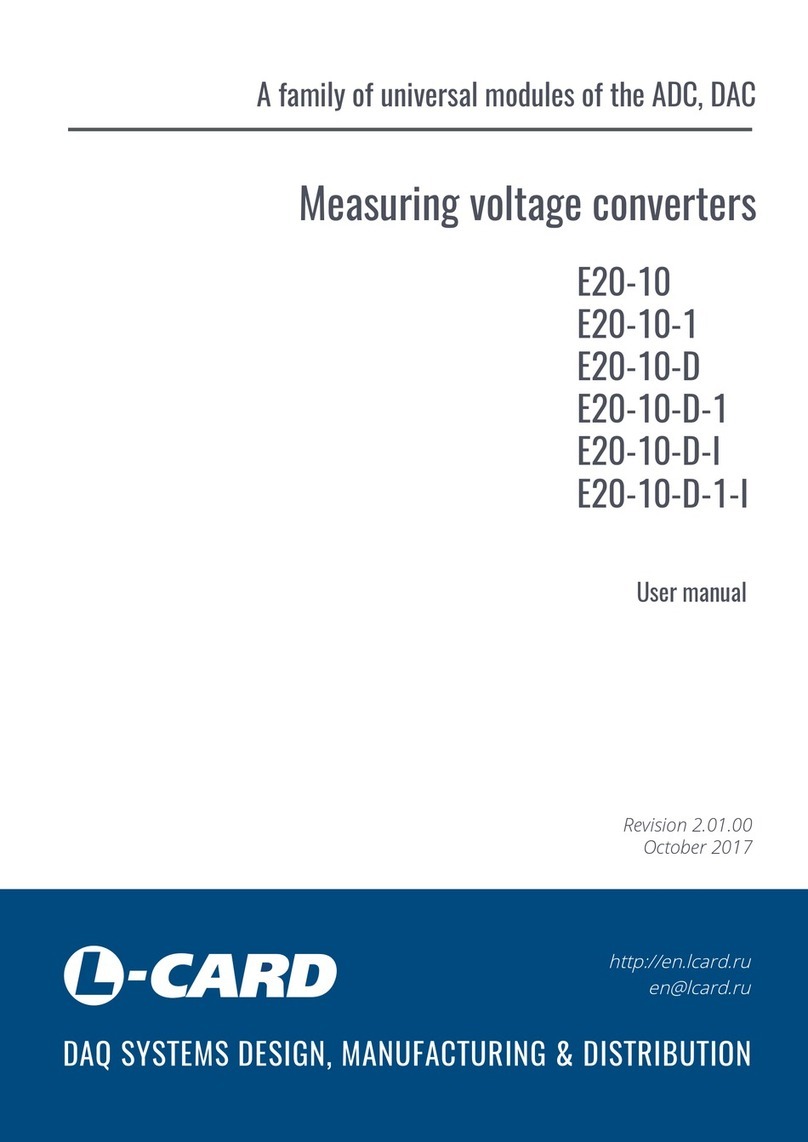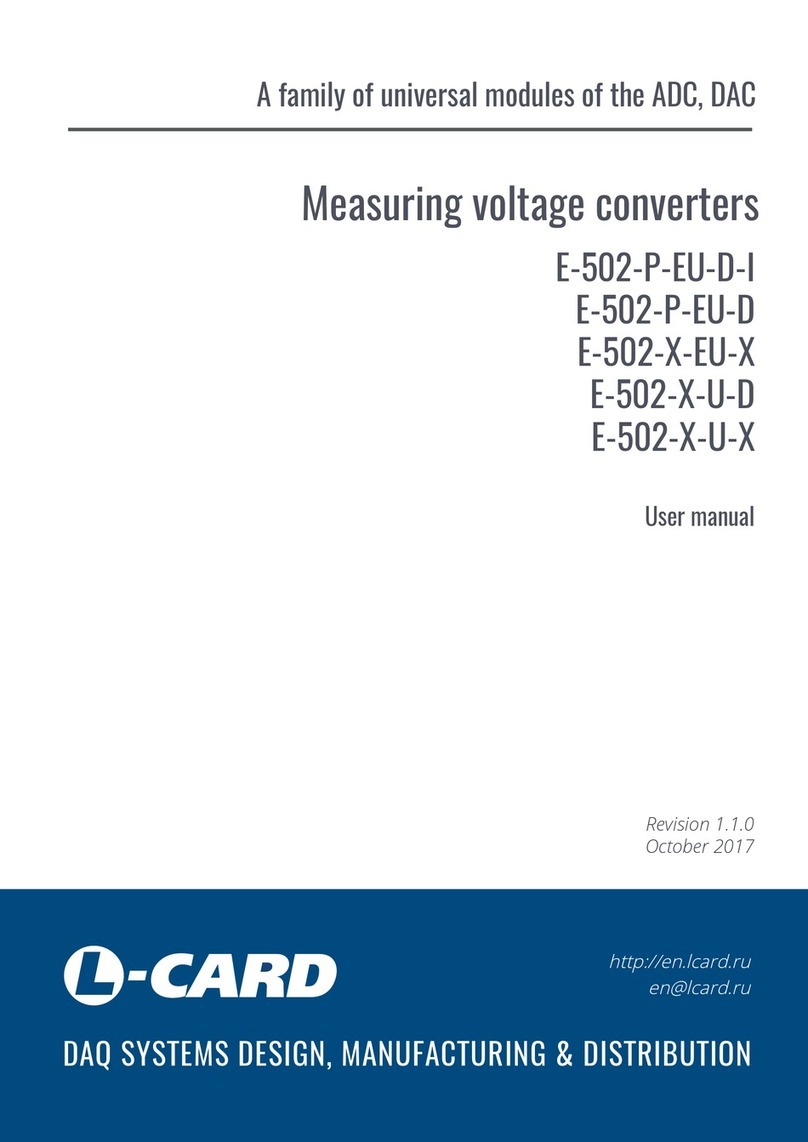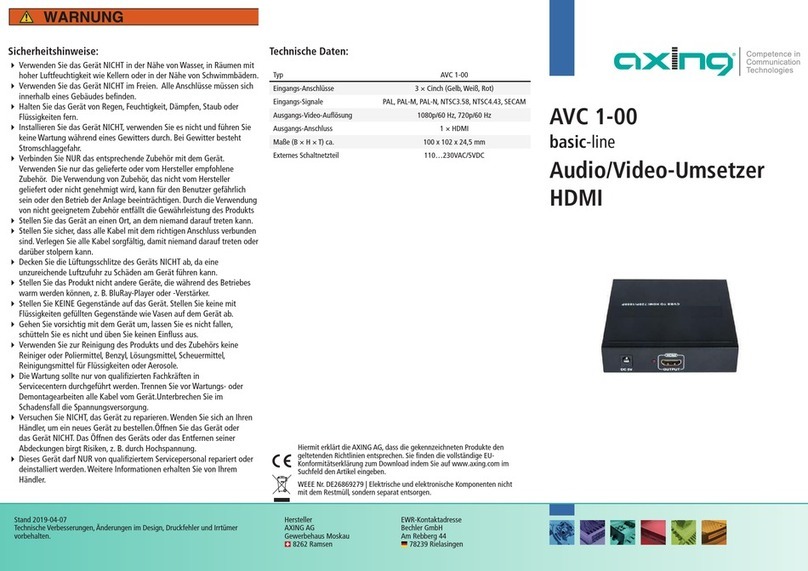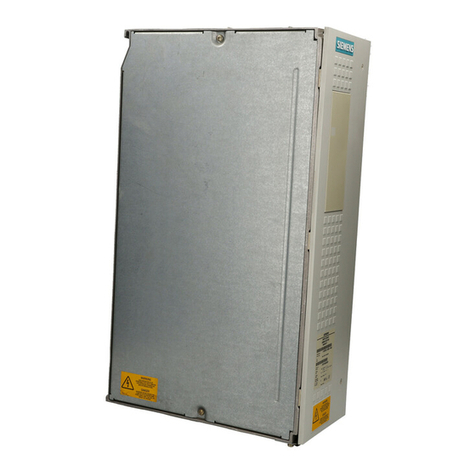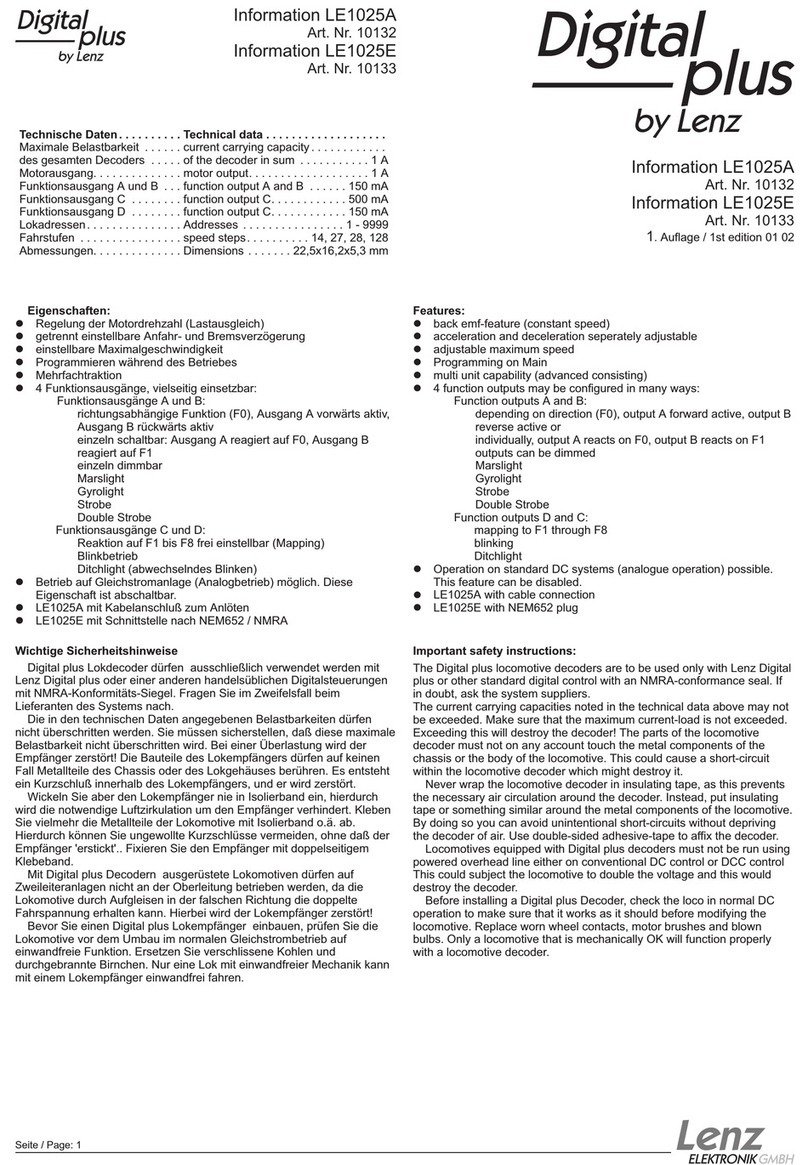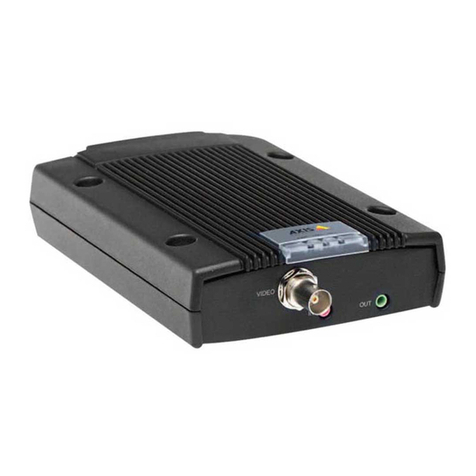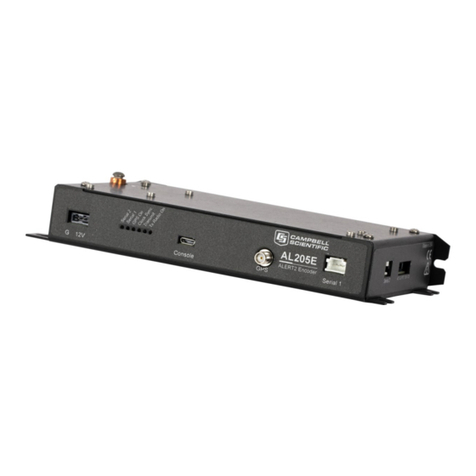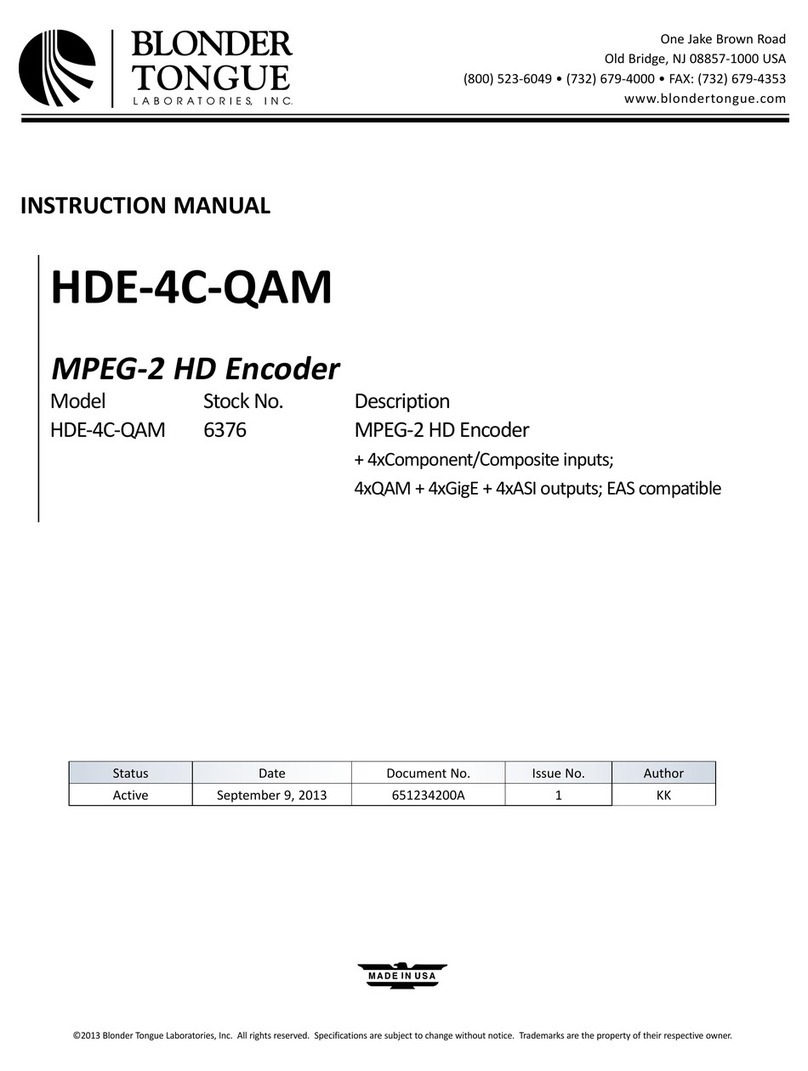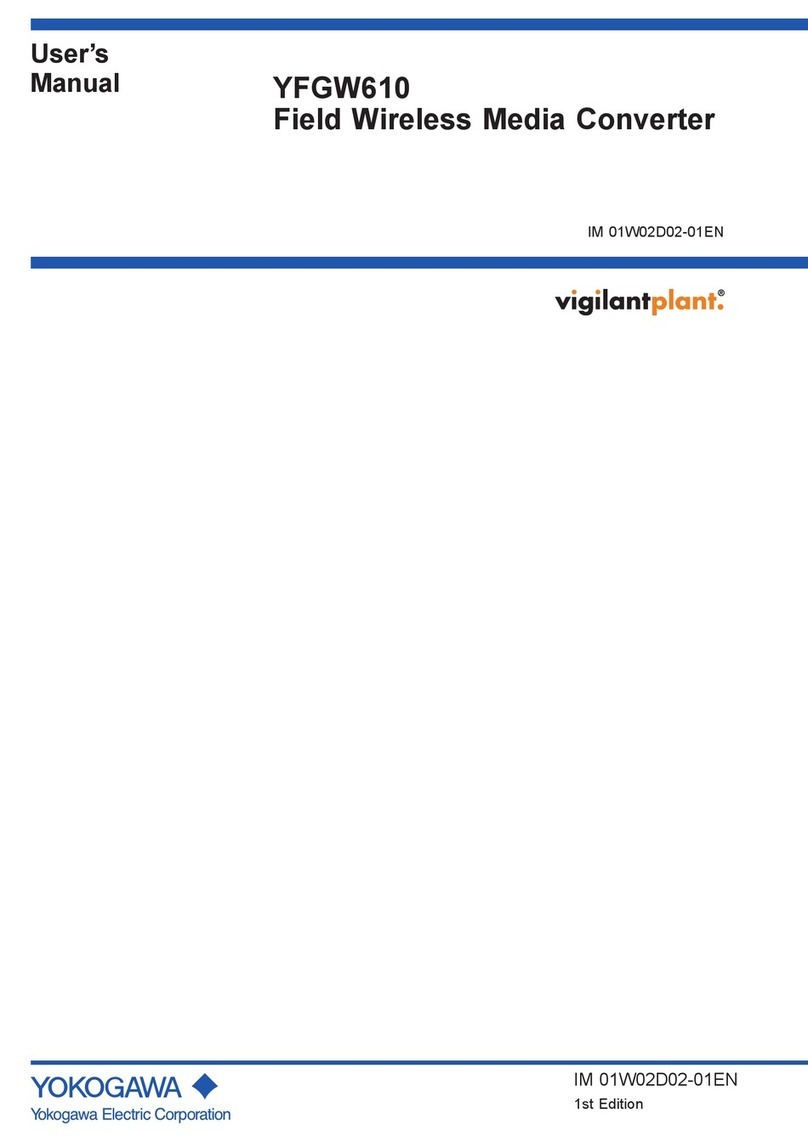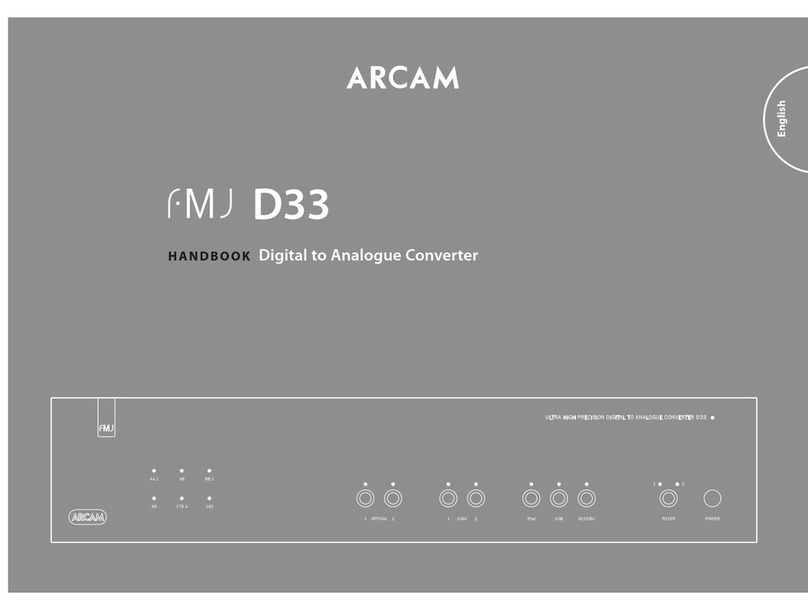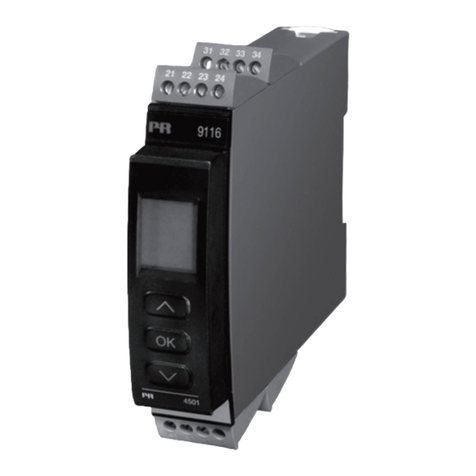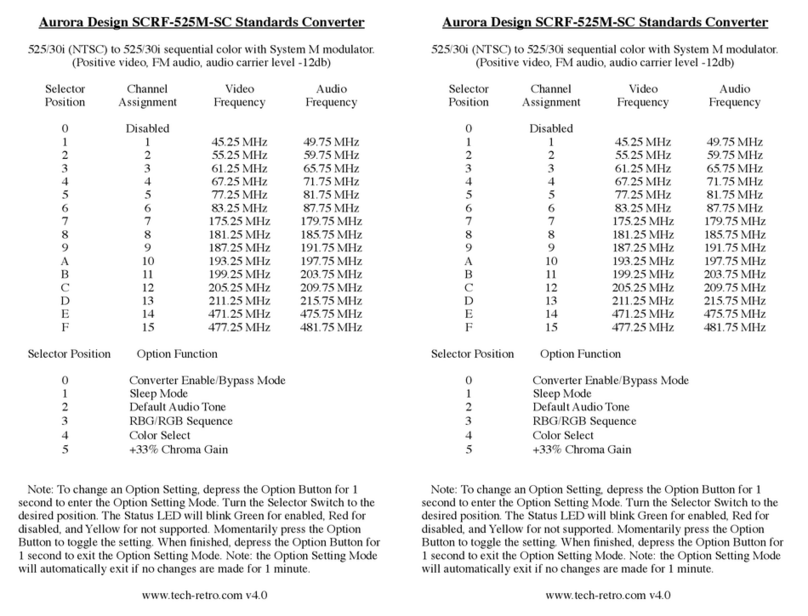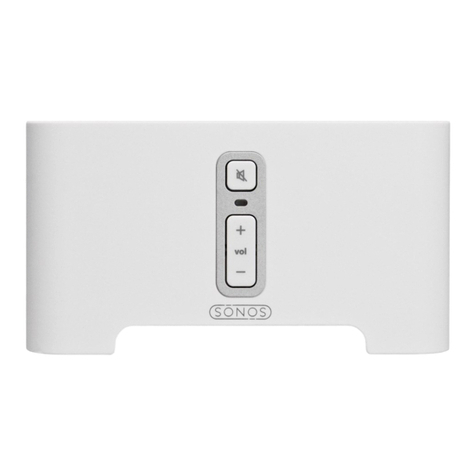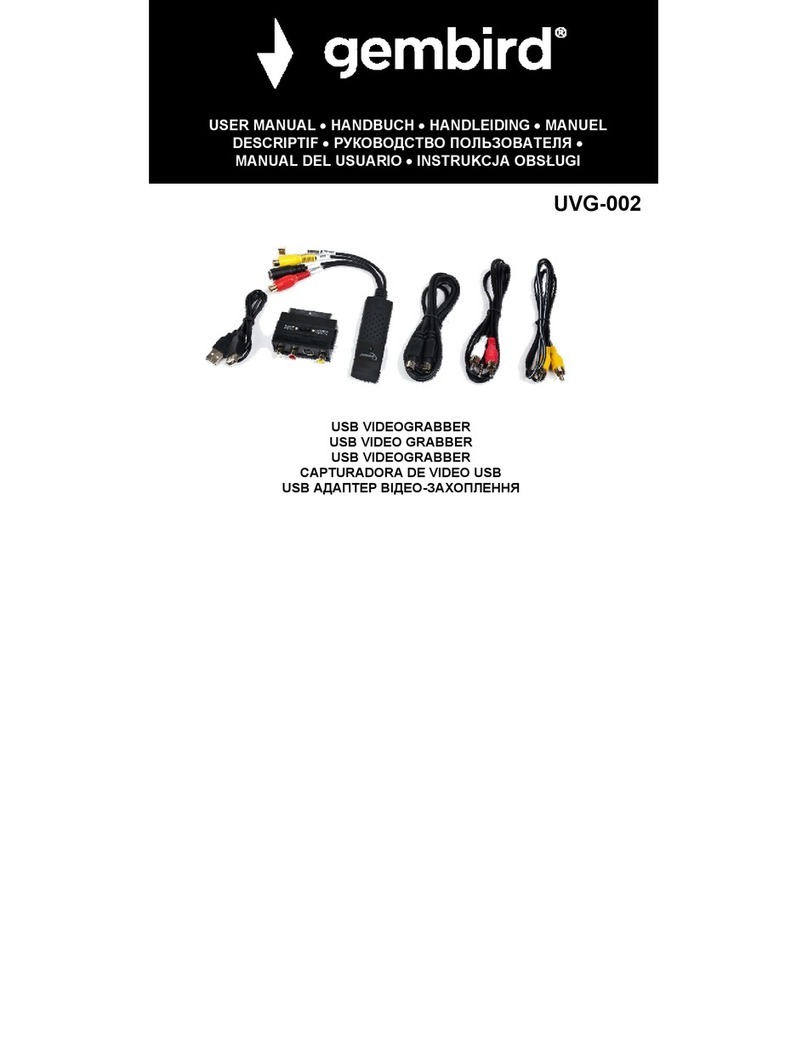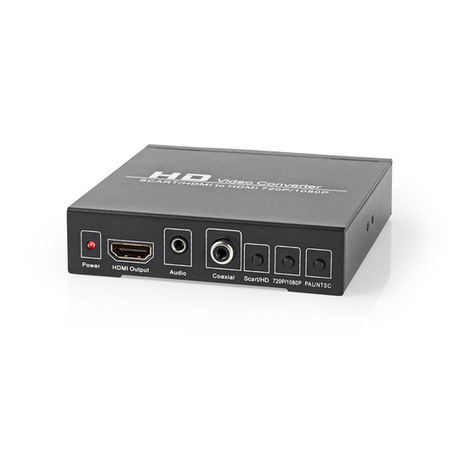L-Card L-502-P-G-D-I User manual

2
General description.
Author of the manual
Garmanov A.V.
L-Card LLC
117105, Moscow, Varshavskoye shosse, 5, block 4, bld. 2
tel.: (495) 785-95-19
fax: (495) 785-95-14
Internet contacts
http://en.lcard.ru
E-Mail:
Sales department: en@lcard.ru
Technical support: en@lcard.ru
L-502 Module © Copyright 2006-2017, L-Card LLC. All rights reserved.

3
Revision history of this document
Date
Document
revision
Contents of the change
06.2012
1.0.1
Preliminary data
07.2012
1.0.2
Preliminary data
11.2012
1.0.3
The information on connection L-502 is added, as well as
Chapter 6 an item 4.2.3.1, item 4.2.4.1, item 4.2.5, item 4.3,
item ... is added by 4.4.
01.2014
1.0.4
Edited
table 4-1
, supplemented paragraphs.
1.3
,
2.4
,
2.5
.
4.2.4
05.2014
1.0.5
A comment is added to the item
5.1.2
, page
51
06.2014
1.0.6
Different names of signals are fixed: SYNC_IN, SYNC_OUT is
changed to START_IN, START_OUT, accordingly.
05.2015
1.0.7
Added item
3.3.5
, item .
5.5.1
03.2016
1.0.8
Added
Chapter 7
02.2017 1.0.9 Paragraph added
3.3.4.1
07.2017 1.0.10 A warning is added to item.
3.3.5.2
10.2017 1.1.0
Added industrial design versions.
The characteristics according to the results
of preparation of the family of L-CARD voltage measuring
converters for certification as Means of Measurement are brought
into correspondence. Added to item
3.3.8
. Paragraph added
4.5
When reading this document electronically, to facilitate navigation, use the electronic
tree of the table of contents (for example, Acrobat Reader), as well as hyperlinks within the
document.

4
General description.
Contents
CHAPTER 1. GENERAL DESCRIPTION................................................................... 7
1.1. Order information............................................................................................................... 8
1.1.1. Order kit.............................................................................................................................. 8
1.2. Consumer properties of L-502 in comparison with L-780(М), L-783(М), L-791....8
1.3. Appearance and main structural elements ...................................................................11
1.4. Documentation structure for L-502 ...............................................................................13
CHAPTER 2. INSTALLATION AND CONFIGURATION. ....................................... 14
2.1. Configuration L-502......................................................................................................... 14
2.1.1. Backup boot configuration .............................................................................................. 14
2.1.2. The configuration of the outputs DAC1 and DAC2......................................................15
2.1.3. Configuring the resolution of the active state of the digital outputs.............................15
2.2. Installing the L-502 in your computer...........................................................................16
2.3. Function of the status LED on the front panel............................................................. 16
2.4. Serial number. L-502 version number. Module identification in a multi-module
configuration.......................................................................................................................................... 17
2.5. Software installation ......................................................................................................... 18
CHAPTER 3. THE DEVICE AND PRINCIPLE OF OPERATION L-502................. 19
3.1. Conventions........................................................................................................................ 19
3.1.1. Convention on numbering............................................................................................... 19
3.1.2. The assumption on the concept of "frequency" .............................................................19
3.1.3. The agreement on the terms "card", "board" and "module"..........................................19
3.2. Introduction (L-502 concept) ..........................................................................................19
3.3. Operation principle........................................................................................................... 22
3.3.1. Reference frequency ........................................................................................................ 22
3.3.2. ADC channel.................................................................................................................... 22
3.3.3. Digital input channel........................................................................................................ 23
3.3.4. Digital output and DAC channels................................................................................... 23
3.3.5. General principle for synchronization in L-502............................................................. 24
3.3.6. Setting the ratio between the time of setting the signal and the resolution for each
channel of the ADC is a unique possibility of the L-502!.................................................................... 26
3.3.7. Relative switching delays in ADC channels. ................................................................. 28
3.3.8. Relative delays of the ADC, DAC and I/O channels.....................................................29

5
3.4. Operation principle and function circuit.......................................................................31
CHAPTER 4. CONNECTION OF SIGNALS. ........................................................... 33
4.1. GND, DGND, AGND circuits..........................................................................................33
4.2. L-502 connectors description. .........................................................................................33
4.2.1. L-502 external signal connector...................................................................................... 33
4.2.2. Connecting the cable shield............................................................................................. 33
4.2.3. Internal signal L-502 connector. ..................................................................................... 36
4.2.4. Internal connector of intermodule synchronization.......................................................38
4.2.5. JTAG connector. .............................................................................................................. 41
4.3. The maximum allowable conditions at the inputs and outputs of signal lines........42
4.4. ADC input operation voltage range ...............................................................................44
4.5. Necessary conditions for correct connection and correct settings of the input of the
ADC L-502. ............................................................................................................................................ 45
4.5.1. The physical causes of possible problems......................................................................45
4.5.2. Conditions for correct connection and settings L-502...................................................46
4.6. Calculation of the total load power of L-502 output circuits .....................................48
CHAPTER 5. SPECIFICATIONS.............................................................................. 49
5.1. ADC..................................................................................................................................... 49
5.1.1. Limits of the permissible relative basic error of measuring the AC voltage................50
5.1.2. ADC own input noise. ..................................................................................................... 51
5.1.3. ADC inter-channel passing.............................................................................................. 51
5.2. DAC..................................................................................................................................... 52
5.2.1. AC voltage playback error............................................................................................... 52
5.3. Digital inputs...................................................................................................................... 53
5.4. Digital outputs.................................................................................................................... 54
5.5. Synchronization in L-502................................................................................................. 54
5.5.1. Synchronization characteristics....................................................................................... 54
5.5.2. Intermodule synchronization interface ........................................................................... 55
5.6. Characteristics of standard interfaces........................................................................... 55
5.7.Power supply system and galvanic isolation................................................................. 56
5.8. Construction specification. .............................................................................................. 58
5.9. Environmental conditions................................................................................................ 58
5.9.1. Normal conditions............................................................................................................ 58
5.9.2. Operating conditions........................................................................................................ 58
CHAPTER 6. CONNEXION SAMPLES.................................................................... 59

6
General description.
6.1. ADC entry point connection............................................................................................59
6.1.1. Connecting to the ADC entry point of single-phase voltage source............................. 59
6.1.2. Connection to ADC input with up to 16 differential voltage sources ..........................62
6.1.3. Connection to the ADC input for the case where the common wire of the signal
sources has a offset potential Ucm of max. ± 1 V relative to the AGND circuit............................... 63
6.1.4. Measurement of the voltage drop on the circuit section in the differential mode (up to
16- channels)64
6.1.5. Differential connection of the transformer (throttle) winding with midpoint and offset
potential with respect to AGND............................................................................................................. 64
6.1.6. Example of mixed connection of voltage sources "with common ground" and
differential. 64
6.1.7. Connecting a power supply to the ADC input ...............................................................65
6.1.8. Consistent connection of remote current sources or voltage through a long line with a
wave resistance of Zw with load on the side of the receiver................................................................66
6.1.9. Differential connection of an isolated current source or voltage ..................................66
6.1.10. The coordinated connection of a remote voltage source through a pair of long line
with a wave resistance Zw with matching on the signal source side...................................................67
6.2. Connecting the DAC outputs........................................................................................... 68
6.2.1. 2-channel output ±5 V ..................................................................................................... 68
6.2.2. Single-channel differential output ±10 V....................................................................... 68
6.3. Connecting the digital inputs and outputs. ...................................................................69
6.3.1. Connecting the LED or the optron input. Option 1........................................................ 69
6.3.2.Connecting the LED or the optron input. Option 2........................................................ 69
6.3.3. Connecting a contact to a digital input ........................................................................... 69
BIBLIOGRAPHY.......................................................................................................... 72
LIST OF TABLES. ....................................................................................................... 72
LIST OF FIGURES....................................................................................................... 72
CONTENTS.................................................................................................................... 4

Chapter 1. General description.
L-Card data acquisition system L-502 based on the PCI Express interface of modern
computer motherboards. L-502 – this system of the proprietary development of the "L-Card" LLC,
it is made on the basis of high-tech production of the company, it provides its own technical support
and maintenance.
The most important characteristics of L-502:
•ADC: 16 bits, conversion frequency up to 2 MHz, with switching to 16 differential channels or 32
channels with common ground. Subranges: ±10 V”, “±5 V”, “±2 V”, “±1 V”, ±0.5 V, ±0.2 V.
•DAC (optional): 16 bits, 2 channels, output ± 5 V, asynchronous or synchronous mode with a
conversion frequency of up to 1 MHz for each channel.
•Digital input: up to 18 digital inputs of general purpose, asynchronous or synchronous data
collection mode with a frequency of up to 2 million words per second.
•Digital output: up to 16 digital outputs of general purpose, with separate control of the output
resolution of the high and low byte, asynchronous or synchronous data output mode with a
frequency of up to 1 million words per second.
•Processor Blackfin 530 MHz, 32 MB RAM, JTAG input (optional) allows you to use the ready
"advanced" signal processing and control functions inside the L-502 or independently engage in
low-level programming of these functions.
•Galvanic isolation (optional) provides isolation of digital and analog signal inputs/ outputs to all
circuits of the computer.
The above "optional" is reflected in the L-502 module designation system on fig. 1-1.
The system can consist of one or more modules (boards) L-502, synchronized from each
other, from an internal or external synchronization source.
L-502- - - -
Модификация
преобразователя
PПроцессор Blackfin 500 МГц, ОЗУ
32 МБ и разъём JTAG присутствуют
XОтсутствуют процессор Blackfin,
ОЗУ и разъём JTAG
G
X
Гальваноразвязка
присутствует
DЦАП (2 канала)
присутствует
ЦАП
отсутствует
Гальваноразвязка
отсутствует
Преобразователи напряжения
измерительные
I+5…+55 °С
-40…+60 °С
С лакировкой
Нет
индекса
Нет
индекса D
Fig. 1-1. Symbol system for L-502 module
Measuring voltage converters
Converter
modification
No index
No D index
With polish
There is a DAC
(2 channels)
No DAC
There is a galvanic
i
solation
No galvanic isolation
There are Blackfin processor 500 MHz, 32
MB RAM and JTAG connector
There is no Blackfin RAM processor and
JTAG connector

8
General description.
1.1. Order information
Available modifications for L-502 for the order:
L-502-P-G-D-I
L-502-P-G, L-502-P-G-D
L-502-X-G, L-502-X-G-D
L-502-X-X. L-502-X-X-D
When choosing the modification of the L-502 module for the order, it should be noted that
when you contact the L-Card sales department, the previously purchased version of the L-502
module can be modified only in the direction of installing the DAC. In other words, only the
following modifications of the L-502 modules are technically recognized:
L-502-P-G
L-502-P-G-D
L-502-X-G
L-502-X-G-D
L-502-X-X
L-502-X-X-D
This work on the installation of a DAC can be carried out exclusively in the L-Card, while the
original warranty period of 1.5 years for the product L-502 is retained.
1.1.1.Order kit
1. Module L-502 (in accordance with the ordered modification)
2. Cable part of DB-37F connector;
3. Cover for DP-37 connector
4. Jumper for configuration of outputs (3 pieces are pre-installed on the board + 2 pieces in
the kit).
5. The synchronization cable is supplied separately. The cable is used to connect two L-502
modules. In the general case, for the connection of N pcs. of L-502 modules on one
motherboard, you will need (N-1) pcs. of synchronization cables.
1.2. Consumer properties of L-502 in comparison with
L-780(М), L-783(М), L-791
The new family of L-502 in its overall technical characteristics is the development of the line
L-780 (M), L-783 (M), L-791 at a higher technological level. There is considerable compatibility
of L-502 in the type and purpose of the contacts of signal connectors, but, unfortunately, there is no
software compatibility with them. The L-502 module is more versatile in its capabilities as it
practically covers the range of tasks that was solved earlier within the framework of the 700th
family, in addition, it offers fundamentally new opportunities. A comparison of the technical
characteristics of the L-502 module with its predecessors of the 700th family is shown in table 1-1.
The following conventions are adopted in the table, which are consistent with the versions of
modifications L-502 in accordance with fig. 1-1:
•[P] – only for L-502-P-░-░ (with processor)
•[P] – only for L-502-X-░-░ (without processor)

9 1.2: Consumer properties of L-502 in comparison with L-780(М), L-783(М), L-791
•[G] – only for L-502-░-G-░ (with galvanic isolation)
•[D] – only for L-502-░-░-D (with DAC)
Table 1-1. Comparison with L-502 c L-780(M), L-783(M) and L-791
Characteristics L-502
L-780(М) L-783(М) L-791
Bit depth:
- ADC
- DAC
- Dig. input
- Dig. output
161
16 [D]
18
16
14
12
16
16
12
12
16
16
14
12
16
16
Max. speed of o/i, in
synchronous mode, n. count./s 2
- ADC
- DAC (for each channel) 2000
1000 [D] 400
100 3000
100 400
100
- Digital input
- Digital output 2000 No synchronous mode 400
1000 No synchronous mode
ADC channels 16 differential/ 32 with common ground
ADC subranges, V ±10, ±5, ±2, ±1,
±0,5, ±0,2 ±5, ±1,25,
±0,3, ±0,08 ±5, ±2,5,
±1,25, ±0,6
±10, ±5, ±2,5,
±1,25, ±0,6,
±0,3, ±0,15,
±0,07
ADC common-mode signal
range, V ±1 ±5 ±5 ±10
DAC range, V
(output current, mA) ±5
(10) [D] ±5
(1) ±5
(1) ±5
(1)
The word width of the module
data, bit 32 16 16 32
Multiple-frequency capability of
data collection Yes [P] No No Yes
Index
3
data format Yes No No No
Internal data calibration Yes [P].
Only for ADC [P]
Only for ADC Only for ADC No
Ability to set ADC channel
resolution/ timing Yes No No No
Processor (core clock) ADSP-BF523
(530 MHz) [P] ADSP-2185(М) No
29,5 MHz 40 MHz
Processor's external RAM 32 MB [P] No No No
1From the L-502, ADC data, expanded to 24 bits as a result of arithmetic processing, is transferred to the computer.
2A reference is the full word of the data of the ADC, DAC or input/ output with the bit width adopted in this product.
3When the data word format contains information about the channel number

10
General description.
Characteristics L-502
L-780(М) L-783(М) L-791
The amount of user area of
Flash-memory 1 MB 32 bytes 32 bytes 64 Kbyte
JTAG port to adjust the
embedded software Yes
[P] No No No
The possibility of custom low-
level programming Yes
Yes
Yes
No
Independent software access to
the memory of the signal
processor
Yes
[P] Yes Yes No
DMA in PCI BUS MASTER
mode Yes No No Yes
Interface PCIe x1 PCI 32 bit, slot 5V
Synchronization:
- External data collection start
- External frequency of ADC
conversion
- From the next module
- Analogous
Yes
Yes
Yes
Yes
Yes
No
No
Yes
Yes
No
No
Yes
Yes
No
No
No
The technology of the basic
interface element FPGA
Altera Cyclone IV PLX Tech.
PLX9050/9030 PLX Tech.
PLX9050/9030 FPGA
Altera
Acex1K
Indication on the panel Yes No No No
The possibility of remote
firmware update FPGA Yes No No Yes
Program activation of pull-up
resistors of digital inputs Yes No No No
Independent resolution of the
active state of the digital output
of the low and high byte
Yes No No No
Full list of L-502 characteristics – Chapter 5 on page 49.
!
Already today, the architecture of the L-502 is not limited to just this one project by L-Card
LLC. The new E-502 with USB and Internet interfaces has a continuity of architecture with
L-502: Only the interface with the PC with the same functionality as the L-502 was subjected
to processing, except for small functional differences. The E-502 and L-502 software also
has continuity (common library functions of the upper software level of the PC, identical to
the software at the Blackfin level).

11 1.3: Appearance and main structural elements
1.3. Appearance and main structural elements
Depending on the version of the module (item 2.4, p.17), there are differences in the location
of the inter-module sync connector and the output enable connector. Unlike the previous versions,
in version 3, an angular synchronization connector is used, which allows connecting the
synchronization cable when the L-502 module is already inserted and fixed in the system unit along
with the installed adjacent PCI-Express modules.
Светодиод
состояния
Внешний
сигнальный
разъём Внутренний
сигнальный
разъём
Разъём
межмодульной
синхронизации
Разъём
конфигурации
резервной
загрузки
(п.2.1.1)
Разъём
конфигурации
разрешения
выхода
(п.2.1.3)
8-ми значный
серийный
номер
Разъём
JTAG
Технологические
разъёмы
(подключаться
запрещено)
Разъём
конфигурации
выходов DAC1,
DAC2 (п.2.1.2)
Разъём для
установки ЦАП
Разъём
PCI Express X1
Базовый
интерфейсный
элемент - FPGA
Cyclone IV
Название
модуля
Элементы
гальвано-
развязки
Fig.1-2. L-502 version 3 (face layout)
JTAG
connector
Internal
signal
connector
Status LED
Backup
boot
configuration
connector
(2.1.1)
Eternal
signal
connector
Output
resolution
configuration
connector
(s.2.1.3)
Intermodule
synchronization
connector
8-digit
serial
number
Elements of
galvanic
isolation
Module
name
Outputs
configuration
connector
DAC1, DAC2
(s.2.1.2)
Connector for
DAC installation
Connector
PCI Express X1
The basic
interface element
is FPGA Cyclone
IV
Technological
connectors
(forbidden to
connect)

12
General description.
Светодиод
состояния
Внешний
сигнальный
разъём Внутренний
сигнальный
разъём
Разъём
межмодульной
синхронизации
Разъём
конфигурации
резервной
загрузки
(п.2.1.1)
Разъём
конфигурации
разрешения
выхода
(п.2.1.3)
8-ми значный
серийный
номер
Разъём
JTAG
Технологические
разъёмы
(подключаться
запрещено)
Разъём
конфигурации
выходов DAC1,
DAC2 (п.2.1.2)
Разъём для
установки ЦАП
Разъём
PCI Express X1
Базовый
интерфейсный
элемент - FPGA
Cyclone IV
Название
модуля
Элементы
гальвано-
развязки
Fig. 1-3. L-502 version 1 or 2 (face layout)
Connector
PCI Express X1
Connect
or
JTAG
Technological
connectors
(forbidden to
connect)
Output resolution
configuration
connector
(s.2.1.3)
Internal
signal
connector
8-digit
serial
number
Backup boot
configuration
connector
(2.1.1)
Eternal
signal
connector
Module
name
Intermodule
synchronization
connector
Connector for DAC
installation
The basic
interface element
is FPGA Cyclone
IV
Outputs
configuration
connector
DAC1, DAC2
(s.2.1.2)
Elements
of galvanic
isolation
Status
LED

13 1.4: Documentation structure for L-502
ОЗУ -
SDRAM
32 MB
Процессор -
Blackfin
Кронштейн для
крепления в
системном блоке
Fig.1-4. L-502 (back layout)
1.4. Documentation structure for L-502
A complete guide to the L-502 is divided into four separate books:
•L-502. User Manual
•L-502. Programmer Manual
•L-502. Connexion samples
•L-502. Low-level description
RAM
SDRAM
32 MB
Blackfin
processor
Bracket for
mounting in the
system unit.

14
Installation and configuration.
Chapter 2. Installation and configuration.
2.1. Configuration L-502.
Here, the hardware settings of the L-502 are considered, which must be done before the L-502
module is installed in the computer. These settings are made by jumper, which you need to put (or
not) on the corresponding pair of contacts, indicated below in the tables with conditional numbers.
2.1.1.Backup boot configuration
1
2
Jumper for
1-2 FPGA is loaded with the main firmware from the
Flash-memory.
This loading mode is considered the main mode,
and the L-
502 always comes with a jumper set to
contacts 1-2.
No jumper
FPGA is loaded with a backup copy of the
firmware from Flash-memory.
This loading mode is considered auxiliary and the
user can apply it if, for some reason, the main flash
memory firmware has been corrupted and, as a
result, the L-502 device has ceased to be detected
by the operating system. See Note.
Note: Putting or removing the backup jumper should be done with the computer system's
completely de-energized computer (the usual shutdown of the computer - the software or the button
at the front of the system unit - is not enough, since the system unit has the "standby" power)

15 2.1: Configuration L-502.
2.1.2.The configuration of the outputs DAC1 and DAC2
3
4
56
7
8
910
No jumper on 3,4,5,6 The contact "DAC1" is not
connected to the external signal
connector, see item 4.2.1, p. 33
Jumper on 3-4 The contact "DAC1" on the
connector is connected to the
DAC - channel 1
Jumper on 3-5 The contact "DAC1" on the
connector is connected to +15V
Jumper on 3-6 The contact "DAC1" on the
connector is connected to AGND
No jumper on 7,8,9,10 The contact "DAC2" is not
connected on the connector
Jumper on 7-8 The contact "DAC2" on the
connector is connected to the
DAC - channel 2
Jumper on 7-9 The contact "DAC2" on the
connector is connected to -15V.
Jumper on 7-10 The contact "DAC2" on the
connector is connected to the
DGND digital ground circuit.
2.1.3.Configuring the resolution of the active state of the digital outputs
For version 1 or 2 :
11 12
13 14
For version 3:
Jumper on 11-12 Forced output enable of the low-
order byte, see 4.2.3, p.36.
No jumper on
11-12 The resolution of the low byte
output depends on the program
setting.
Jumper on 13-14 Forced output enable of high
byte.
No jumper on
13-14 The output enable of the high
byte depends on the program
configuration.

16
Installation and configuration.
11 12
13 14
2.2. Installing the L-502 in your computer
The L-502 module can be installed in any PCI Express card slot of any size (x1, x2, x4, x8,
x12, x16 and x32) from 1.0 to 3.0.
Before installing the L-502 in the computer, set the configuration jumper to the desired
position, i. 2.1.
To install, and also to remove L-502 is allowed only when the computer's system unit is de-
energized. "Hot connection" is not supported!
It is recommended to install L-502 in the system block with good air circulation in the
interior.
It is recommended to avoid electrostatic discharges during the installation of L-502 in the
computer. When handling the L-502, keep the module behind the metal panel.
It is not recommended to install the L-502 in an adjacent slot next to the heating radiator of an
adjacent module, for example, in the vicinity of a powerful graphics card.
The two 6-threaded screws on the L-502 bracket must be tightened securely, make sure of this
before installing the L-502.
The design of the L-502 is in strict accordance with the requirements of the PCI Express
specification. But in the real case, it is also important: the quality of the computer chassis, the errors
in installing the motherboard in the computer, the design features of the particular motherboard, the
design features of the card in the adjacent slot. Due to a combination of these factors when
installing L-502, you may encounter contacting the radiators of the motherboard (and other
structural elements) with the internal electrically conductive elements L-502. It should be specially
noted:
!
Do not touch the L-
502 conductive elements with any other
electrically conductive elements of the motherboard or adjacent PCI/
PCI-E cards.
!
It is not allowed to operate the L-502 with an unsupported bracket.
The standard mounting screws for
the card brackets (or plugs) are
usually included in the computer case kit.
2.3. Function of the status LED on the front panel.
In the usual case, the LED on the front panel indicates the following statuses of the module:
LED status Description
Red light L-502 is on and in the synchronous I/O standby mode.

17 2.4: Serial number. L-502 version number. Module identification in a multi-module
configuration
Green light L-502 is in the synchronous I/O mode.
No lights Power is off.
If more than one L-502 module is used in the computer's system unit, the task is to identify
the module with which the program is currently running. To solve this problem, the software
function of controlling the red glow of the LED is provided. Naturally, the same problem can be
solved by software reading the serial number of the module, however, a comparison with the
number punched on the board will require the opening of the system unit, which is inconvenient for
operation.
2.4. Serial number. L-502 version number. Module
identification in a multi-module configuration
The unique eight-digit product serial number item 1.3, page 11 serves to identify the module
instance throughout the life cycle. The L-502 serial number is program-accessible.
The first digit of the serial number corresponds to the version number of the product L-502.
The product version is changed to improve the design and technological characteristics during the
production "life cycle" of the product. All versions of L-502 are programmed and functionally
identical.
The task of module identification in a multi-module configuration arises because PCI Express
(as well as PCI) -interface historically has never had a software binding to the physical position of
the module in the slot line, and this binding occurs in operating systems when the system is
initialized. If the composition of the equipment has not changed (and all the equipment remains
operative), then there is a hope that the assignment of resources in the system during the
initialization should occur from one computer to another. But in order to reliably compare a
particular instance of the module and its assigned address in a multi-module user program, it is
necessary to bind to the serial number of the L-502 module.

18
Installation and configuration.
2.5. Software installation
To install the necessary drivers and libraries for Windows OS, you must download and
run the installer "L-Card L502 / E502 SDK" http://www.lcard.ru/download/lpcie_setup.exe.
For information on installing the driver and libraries under Linux OS, see the
Programmer Guide, http://www.lcard.ru/download/x502api_en.pdf.

19 3.1: Conventions
Chapter 3. The device and principle of
operation L-502.
3.1. Conventions
3.1.1.Convention on numbering
In all products of the L-Card, the numbering of all physical objects (for example, channel
numbers) in the description of the principle of action and design is always made from one!
This agreement is completely unrelated to the encoding method in programming, where the
numbers of these physical objects can be encoded from scratch or otherwise, in the context of the
corresponding library function or programming language.
3.1.2.The assumption on the concept of "frequency"
In the documentation for L-502, the frequency of discrete signals (for examples,
synchronization signals) is expressed in Hertz, rather than in periods per second, as is customary in
the classical sense of frequency for a non-sinusoidal process.
3.1.3.The agreement on the terms "card", "board" and "module"
Literary PCI or PCI-E is translated as a card (in this case, even a L-card ). But many call it a
board. Following the terms, in this manual we will adhere to the more strict name of this
constructive unit, adopted in the ESKD - module. In particular, we will start from this point by
using the term "multimodule synchronization".
3.2. Introduction (L-502 concept)
For the users who have already used L-780(М), L-783(М), L-761, L-791, the new device L-
502 looks more like the development of this product line (L-7xx) at the new technical level. On the
other hand, it can not be asserted that L-502 is an analog of one of these products or that L-502 is
the mechanical sum of all the best characteristics of these products. Most likely, the L-502 project is
the result of an analysis of the user needs in the market segment of the above products and the result
of an engineering compromise at a modern technical level, where the most popular characteristics in
this product line were first taken into account for most applications in order to obtain the best price-
quality ratio.
L-502 has 6 modifications (fig. 1-1, item 1.1) which are based on the same multilayer printed
board. Modification is achieved by different variants of the factory assembly. If you previously
purchased an L-502 without a DAC, then the L-Card accepts orders for the installation of a DAC.
The remaining options for subsequent changes of the L-502 modifications are not considered
technically feasible.

20
The device and principle of operation L-502.
The presence of the ADSP-BF523 signal processor with RAM (modification L-502-P-░-░) is
considered justified for those users who want to get a maximum of on-board signal processing
capabilities on-board, as well as advanced users to have their own low-level processor
programming, possibly using a JTAG emulator.
The presence of galvanic isolation (modification L-502-░-G-░) is considered necessary if the
sources of L-502 input signals and the load circuit of the output signals are not isolated from the
ground and, at the same time, directly (electrically short) are not connected to the case of the system
unit. The galvanic isolation in L-502 provides isolation of all circuits on the contacts of the internal
and external signal connectors and the inter-module synchronization connector
(fig. 1-3) relative to all circuits of the computer. The signal chains are not isolated between each
other.
The presence of a 2-channel DAC (modification L-502-░-░-D) is necessary if in your task it
is necessary to reproduce the output analog voltage levels or temporary voltage functions.
ADC 16 bits with a conversion frequency of up to 2 MHz with 16/32-channel circuit
switching (up to 16 differential channels, up to 32 with a common ground) with voltage subbands ±
10 V, ± 5 V, ± 2 V, ± 1 V , ± 0.5 V, ± 0.2 V has an analogue path improved with regard to L-7xx
for the following parameters:
•The resolution of the ADC is increased and the signal-to-noise ratio is improved due to the
increase in the ADC bit depth, the quality of the analog path, and also at low data acquisition
frequencies due to the built-in hardware averaging of the sample data within the same channel scan
cycle.
•The interchannel passage for the same test conditions is reduced together with L-7xx: the same
impedances of signal sources and channel switching frequency. In particular, the advantage of L-502
on lower sub-ranges of voltages of ± 0.5 V, ± 0.2 V is gigantic with regard to L-7xx for the same
application conditions.
•The range is ± 10 V compared to ± 5 V in L-783 (M).
Along with the obvious progress in the characteristics of the ADC in L-502, there are trade-offs in
the following characteristics with regard to L-7xx:
•Maximum ADC conversion frequency is limited by 2 MHz (in L-783(M) – 3 MHz).
•Limited to ± 1 V operating range of the input signal at the inputs Y and GND32 (for details, see
4.4).
Instrumental DAC 16 bits 2 channels ± 5 V compared to DAC 12 bits in L-7xx has a much
better resolution, a larger working output current, normalized high-speed transients associated with
the transition from one sample to another, which allows using this DAC in applications, the quality
of the functional generator required from the DAC4. Synchronous (streaming) up to 1 MHz per
channel or asynchronous mode on the selected DAC channel is possible, including mixed
synchronous-asynchronous mode on different channels.
Digital input, up to 18 lines, synchronous mode up to 2 MHz or asynchronous. In
synchronous mode, the stream from digital lines is synchronous with the ADC stream, but separate
and independent of the settings of the ADC data collection frame (the frequency of data collection
by digital lines is set separately and does not depend on the ADC frame settings). Programmable
pull-up resistors to a high logic level on digital inputs.
Digital input, 16 lines. Synchronous as synchronous output up to 1 MHz, and asynchronous is
possible. With synchronous output, the frequency is matched to the frequency of the DAC output.
The output enable allocated for the low and high byte increases the flexibility of using digital lines,
4Strictly speaking, for qualitative sound applications to the DAC, even more stringent requirements are imposed in comparison
with the requirements for the function generators.
This manual suits for next models
6
Table of contents
Other L-Card Media Converter manuals

